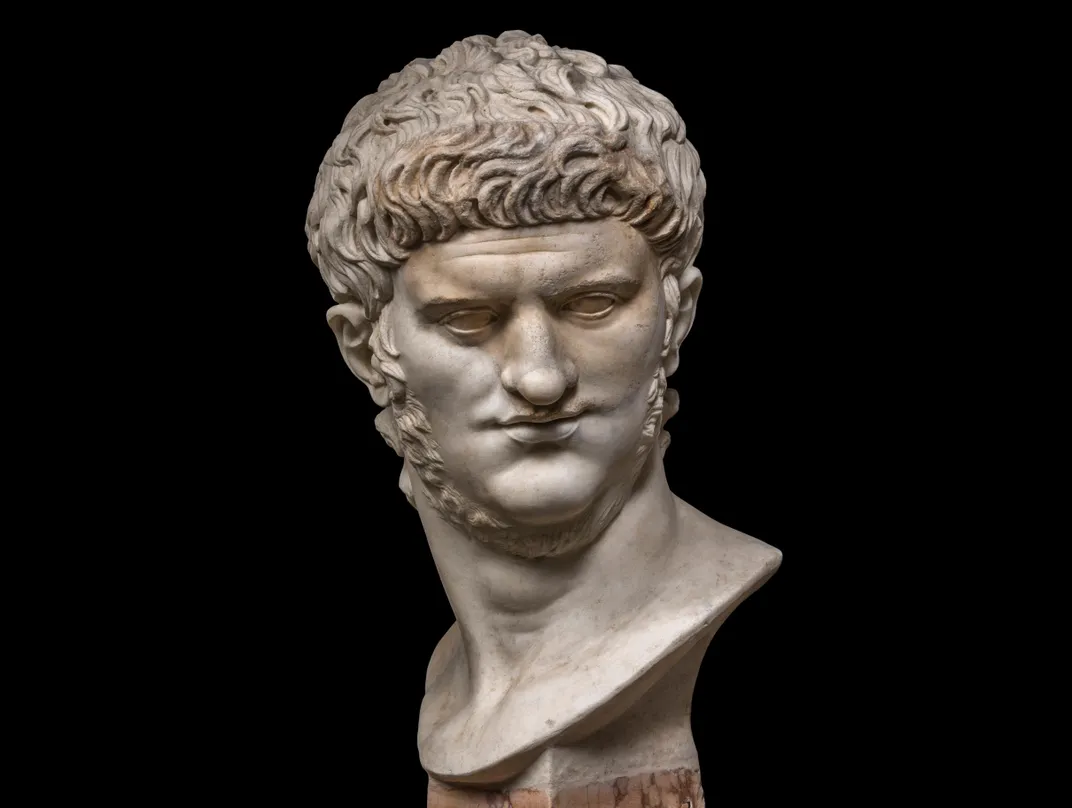Was Emperor Nero Really as Monstrous as History Suggests?
A new exhibition at the British Museum introduces visitors to the man behind the mythical Roman ruler
:focal(514x270:515x271)/https://tf-cmsv2-smithsonianmag-media.s3.amazonaws.com/filer/fb/f0/fbf0666a-2f7b-4858-8956-029f21818ba9/nerooo.jpg)
From ancient texts to modern TV shows, depictions of the Roman emperor Nero have never been flattering. He’s known for murdering family members and strangers alike, as well as starting the Great Fire of Rome that destroyed much of the city in 64 A.D.—not to mention forcing audiences to sit through his terrible singing. But a new exhibition at the British Museum, “Nero: The Man Behind the Myth,” asks visitors to rethink their perceptions of one of the most powerful people in the ancient world.
As Jill Lawless reports for the Associated Press (AP), the show starts with an image from the 1951 film Quo Vadis. The emperor strums a lyre, evoking the famous expression “Nero fiddled while Rome burned.” Then, visitors learn that this story, like many tales of the emperor’s terrible behavior, is a myth.
“Our goal here is to show that this, however popular, image is actually based on very, very biased accounts and therefore we should challenge it,” curator Francesca Bologna tells the AP. “The Nero story is about how we should approach information, how we should always approach our sources critically. This is relevant for Nero, it’s relevant for historians, archaeologists, it is relevant for everyday people living their everyday lives.”
Among the artifacts on view are statues, weapons, jewelry and graffiti. Many come from the London cultural institution’s collection, but others are on loan from museums across western Europe.
The great-great-grandson of Rome’s first emperor, Augustus, Nero came to power in 54 A.D., when he was just 17 years old. He succeeded his stepfather Claudius—who, according to the exhibition, was probably not poisoned by Nero’s mother, as many stories suggest.
/https://tf-cmsv2-smithsonianmag-media.s3.amazonaws.com/filer/e1/2b/e12b8d45-dd07-488b-9eb3-350ad187808b/screen_shot_2021-05-25_at_11206_pm.png)
Accounts written in the decades after the ruler’s death in 68 A.D. portray him as decadent and violent, notes Charlotte Higgins for the Guardian. The Roman biographer Suetonius wrote that Nero entertained himself by wandering the city in disguise, stabbing people and throwing their bodies into the sewers. Tacitus, the famed historian and orator, describes him killing his pregnant wife, Poppaea, by kicking her in the stomach. Other accounts focused on the emperor’s opulent lifestyle and voracious sexual appetite.
Curator Thorsten Opper tells the Guardian that the writers who contributed to Nero’s awful reputation used a standard toolkit of shocking stories about sex and violence to boost their own agenda. They idealized the oligarchic Roman Republic, which ended about 80 years before Nero took power, and disapproved of populist rule by a single person. Opper explains that Nero tried to shore up his position by cultivating the support of ordinary Romans, creating anxiety among the traditional elite.
“The sources need to be seen as texts that have a clear agenda,” Opper says.
In fact, the Art Newspaper’s Maev Kennedy reports, Nero appears to have ruled well in many respects. He reformed the tax system, improved Rome’s food supply, and organized public works projects and popular entertainment like chariot races. He was more than 30 miles away from Rome when it caught fire, and in the disaster’s aftermath, he worked to rebuild the city. (Still, wrote Joshua Levine for Smithsonian magazine last year, Nero did scapegoat Christians for the fire, ordering many “burned in his own gardens, which conforms to the standard Roman legal practice of fitting the punishment to the crime.”)
The exhibition is not intended to glorify Nero. Opper tells the Art Newspaper that it’s likely the emperor murdered his mother or forced her to commit suicide. And it’s true that his grand palace, the Domus Aurea, was wildly extravagant. But Opper notes that murdering relatives and living in an opulent fashion were far from unfamiliar actions undertaken by Roman rulers.

“There was a lot of money sloshing around Nero’s Rome,” he tells the Art Newspaper. “Most of the Domus Aurea seems to have been dining rooms: lavish entertainment would have been expected of him, including hosting the entire Senate. And if you are going to invite 600 people to a banquet once a week, you are going to need a big dining room.”
“Nero: The Man Behind the Myth” places the emperor’s rule in its historical context, according to the AP. One section shows chains that bound enslaved workers forced to mine lead for the empire in Wales. During Nero’s reign, Celtic people in southern England, led by Queen Boudicca, rebelled against Roman rule; the empire also faced war with the Parthian Empire, which was centered in what is now Iran.
Ultimately, facing intractable opposition from within the Roman government, Nero committed suicide at age 30. His death ended the Julio-Claudian Dynasty and led to a chaotic scramble for power known as the Year of the Four Emperors.
Accounts written by Suetonius, Tacticus and others cemented Nero’s villainous reputation for centuries. As Opper tells the Guardian, one bust in the exhibition was heavily restored in the 17th century. An artist who had clearly heard stories about the emperor’s depravity shaped the lower half of the face to create a distinctly unpleasant appearance that may or may not have much in common with the man himself.
“I am not setting out here to rehabilitate Nero as a blameless man,” Opper says to the Art Newspaper. “But I have come to the conclusion that almost every single thing we think we know about him is wrong.”
“Nero: The Man Behind the Myth” is on view at the British Museum in London from May 27 to October 24.
/https://tf-cmsv2-smithsonianmag-media.s3.amazonaws.com/accounts/headshot/Livia_lg_thumbnail.png)
/https://tf-cmsv2-smithsonianmag-media.s3.amazonaws.com/accounts/headshot/Livia_lg_thumbnail.png)